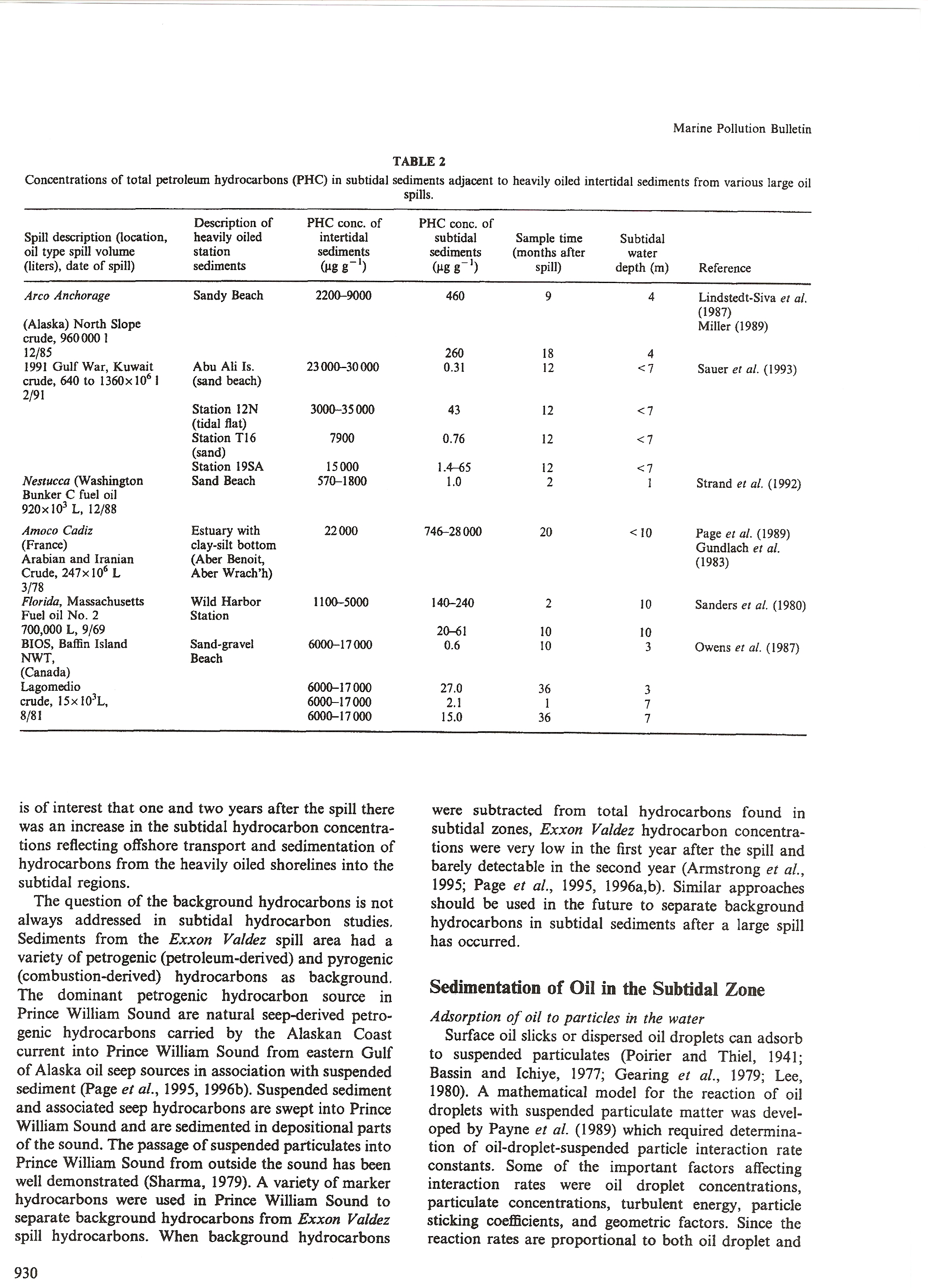15846 scan0024 (4)

Marinę Pollution Bulletin
TABLE2
Concentrations of total petroleum hydrocarbons (PHC) in subtidal sediments adjacent to heavily oiled intertidal sediments from various large oil
spills.
|
Description of |
PHC conc. of |
PHC conc. of | ||||
|
Spili description (location, |
heavily oiled |
intertidal |
subtidal |
Sample time |
Subtidal | |
|
oil type spili volume |
station |
sediments |
sediments |
(months after |
water | |
|
(liters), datę of spili) |
sediments |
(ugg-1) |
(gg g-1) |
spili) |
depth (m) |
Reference |
|
Arco Anchorage |
Sandy Beach |
2200-9000 |
460 |
9 |
4 |
Lindstedt-Siva et al. (1987) |
|
(Alaska) North Slope crude, 9600001 12/85 |
260 |
18 |
4 |
Miller (1989) | ||
|
1991 Gulf War, Kuwait |
Abu Ali Is. |
23000-30000 |
0.31 |
12 |
<7 |
Sauer et al. (1993) |
|
crude, 640 to 1360xl06 1 2/91 |
(sand beach) | |||||
|
Station 12N |
3000-35000 |
43 |
12 |
<7 | ||
|
(tidal Hat) Station T16 (sand) |
7900 |
0.76 |
12 |
<7 | ||
|
Station 19SA |
15000 |
1.4-65 |
12 |
<7 | ||
|
Nestucca (Washington Bunker C fuel oil 920x 103 L, 12/88 |
Sand Beach |
570-1800 |
1.0 |
2 |
1 |
Strand et al. (1992) |
|
Amoco Cadiz |
Estuary with |
22000 |
746-28000 |
20 |
<10 |
Page et al. (1989) |
|
(France) |
clay-silt bottom |
Gundlach et al. | ||||
|
Arabian and Iranian |
(Aber Benoit, |
(1983) | ||||
|
Crude, 247xl06 L 3/78 |
Aber Wrach’h) | |||||
|
Florida, Massachusetts |
Wild Harbor |
1100-5000 |
140-240 |
2 |
10 |
Sanders et al. (1980) |
|
Fuel oil No. 2 700,000 L, 9/69 |
Station |
20-61 |
10 |
10 | ||
|
BIOS, Baffin Island |
Sand-gravel |
6000-17000 |
0.6 |
10 |
3 |
Owens et al. (1987) |
|
NWT, (Canada) Lagomedio |
Beach |
6000-17000 |
27.0 |
36 |
3 | |
|
crude, 15xl03L, |
6000-17000 |
2.1 |
1 |
7 | ||
|
8/81 |
6000-17000 |
15.0 |
36 |
7 |
is of interest that one and two years after the spili there was an increase in the subtidal hydrocarbon concentrations reflecting offshore transport and sedimentation of hydrocarbons from the heavily oiled shorelines into the subtidal regions.
The ąuestion of the background hydrocarbons is not always addressed in subtidal hydrocarbon studies, Sediments from the Exxon Yaldez spili area had a variety of petrogenic (petroleum-derived) and pyrogenic (combustion-derived) hydrocarbons as background. The dominant petrogenic hydrocarbon source in Prince William Sound are natural seep-derived petrogenic hydrocarbons carried by the Alaskan Coast current into Prince William Sound from eastem Gulf of Alaska oil seep sources in association with suspended sediment (Page et al., 1995, 1996b). Suspended sediment and associated seep hydrocarbons are swept into Prince William Sound and are sedimented in depositional parts of the sound. The passage of suspended particulates into Prince William Sound from outside the sound has been well demonstrated (Sharma, 1979). A variety of marker hydrocarbons were used in Prince William Sound to separate background hydrocarbons from Exxon Yaldez spili hydrocarbons. When background hydrocarbons were subtracted from total hydrocarbons found in subtidal zones, Exxon Yaldez hydrocarbon concentrations were very Iow in the first year after the spili and barely detectable in the second year (Armstrong et al., 1995; Page et al., 1995, 1996a,b). Similar approaches should be used in the futurę to separate background hydrocarbons in subtidal sediments after a large spili has occurred.
Sedimentation of Oil in the Subtidal Zonę
Adsorption of oil to particles in the water Surface oil slicks or dispersed oil droplets can adsorb to suspended particulates (Poirier and Thiel, 1941; Bassin and Ichiye, 1977; Gearing et al., 1979; Lee, 1980). A mathematical model for the reaction of oil droplets with suspended particulate matter was devel-oped by Payne et al. (1989) which reąuired determina-tion of oil-droplet-suspended particie interaction ratę constants. Some of the important factors affecting interaction rates were oil droplet concentrations, particulate concentrations, turbulent energy, particie sticking coefficients, and geometrie factors. Since the reaction rates are proportional to both oil droplet and
930
Wyszukiwarka
Podobne podstrony:
55750 scan0026 (4) Marinę Pollution Bulletin TABLE 3 Hydrocarbons concentrations in particles collec
11465 scan0028 (3) Marinę Pollution Bulletin their metabolites in invertebrates and fish from subtid
60761 scan0034 (2) Marinę Pollution Bulletin Page, D. S., Foster, J. C., Pickett, P. M. and Gilfilla
scan0022 (5) Pergamon Pil: S0025-326X(97)00078-7 Marinę Pollution Bulletin, Vol. 34, No. II, pp. 928
43959 scan0032 (4) Marinę Pollution BuUetin histopathology of fish, increases in opportunistic speci
18805 scan0030 (2) Marinę Pollulion Bulletin Petroleum hydrocarbons by fish. After metabolism by pha
SCAN0032 Vergence • Vergence is the measure of convergence or divergence of a
więcej podobnych podstron